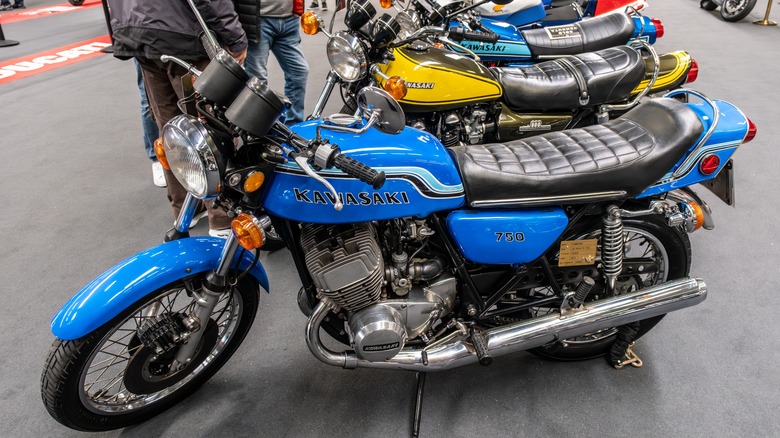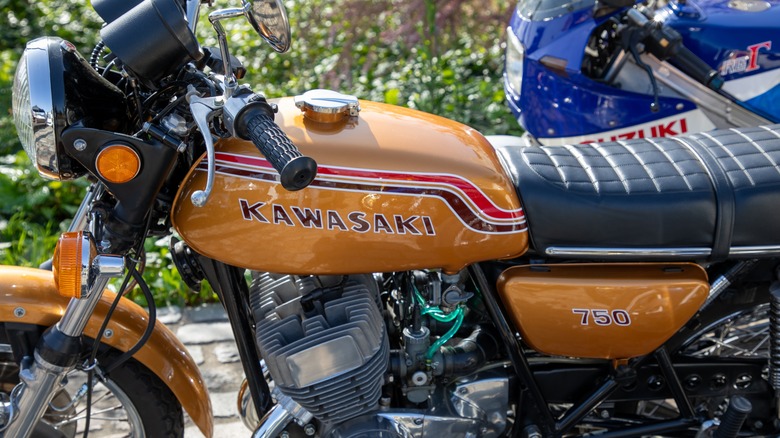Which Is The Most Difficult Kawasaki Motorcycle To Ride? Here's What Riders Are Saying
The motorcycle that wins this trophy, the two-stroke Kawasaki triple also known as "the Widowmaker," is not a difficult motorcycle to ride. It's just a difficult motorcycle to ride without crashing. Back in the 1970s, thrill-seeking bikers met their demise on the Kawasaki H2 Mach IV effortlessly, not least because this 750cc, three-cylinder, inexpensive speed machine was just so easy to get on and go. But when that notoriously abrupt, narrow two-stroke power band kicked in almost uncontrollably at 5000 rpm, riders had trouble not only keeping their front wheel on the ground, but also in maintaining traction on anything other than the stickiest asphalt.
These days, most riders, especially novices, may find the elephantine 2004 Kawasaki Vulcan 2000 more difficult to ride. Heck, most would find it hard just getting its 820-pound curb weight upright off the kickstand, and the degree of difficulty is an indication of whether one should ride it or not. Woe betide if anyone should drop it, too, because a mobile crane may be required to get those shiny wide handlebars back up above the wheels where they belong.
But it is the Kawasaki H2 Mach IV that generates the bulk of the prickly Kawasaki comments from riders. On the r/motorcycles subreddit, Motoguy1251 writes, "My father had one when he was young ... (he) has some crazy stories involving speed and questionable handling." Or as CycleWorld's Kevin Cameron recalls, "that H2 could get you to the scene of your accident quicker than any other."
Nothing a bit of tweaking can't fix
The question "Why does Kawasaki have a bad reputation?" receives a lot of attention on the r/motorcycles subreddit, where it is met with a robust chorus of denial. Riders assert that the big four Japanese motorcycle manufacturers — Suzuki, Yamaha, Honda, and Kawasaki — have nothing but good reputations. However, as Thoreau80 admits, "The biggest issue of old Kawasakis was the handling."
Other riders agree the handling of Kawasaki's large-capacity bikes remained relatively poor well into the 80s. Many complain too much weight is thrown down at the back of the Widowmaker, which, along with its aggressive power band, makes it want to pop wheelies at all the wrong times, in all the wrong places. Getting the thing to steer straight, corner well, and pull up in time is an intractable art, part of the reason why the 750 Kawasaki H2 appears in almost every list of the most dangerous motorcycles ever made.
"The frames and suspension were too weak to handle all that engine power," writes redditor F-21, noting that European manufacturers like Rickman. Seeley, Egli, Bimota and Moto Martin managed to get the balance right when pairing Kawasaki engines with high-end frames and suspension components. On the Tapatalk forum, BBP defends the Kawasaki triple, suggesting its handling problems are nothing that "new fat Excel Rims and tires, taller nitrogen shocks, new swing arm bushings, new all balls wheel bearings, EX brake system, Racetech springs with gold valves, tapered steering bearings, new stabilizer, new handle bars" can't fix.
But isn't this all just urban legend?
But isn't all this hoopla around the Widowmaker no more than an urban myth thrown around an online echo chamber? After all, the H2 engine only put out 74 hp and 57 lb-ft of torque at 6500 rpm — modest figures when compared to the 121.5 lb-ft of the Kawasaki Ninja H2R, with its 322 horses. But it's not only about the numbers: riders point to the shaky swingarm and disappointing drums of the 1970s frame, a far cry from the suspension and brakes of a modern sports bike. But does the H2 deserve the label "worst bike in the world"? This is the question bikerdevkagyaan asks on the r/motorcycles subreddit.
Many riders agree it does, while ironically praising its imperfections. "Perfect bike! Teaches you control, or how to die quickly," writes Popular-Title-391. "One of the most exhilarating and exciting bikes to ride," agrees TheReelMcCoi. One-Positive309 says because Kawasaki kept putting bigger engines into a basic 250cc frame, "bent forks and bent frames were common." Triplesfan says good tires greatly improve the ride, as does reducing the 19" front wheel to 18", giving the bike a more forward-leaning stance.
Fifty years down the track, and the shortfalls of the Kawasaki triples are well known: the savage, high-rpm power band can easily overwhelm both the bike and rider. When kept within a self-imposed 5000 rpm redline, however, the H2 can be a smooth, vintage ride — but its unruly nature makes it one of the worst motorcycles for beginners.


